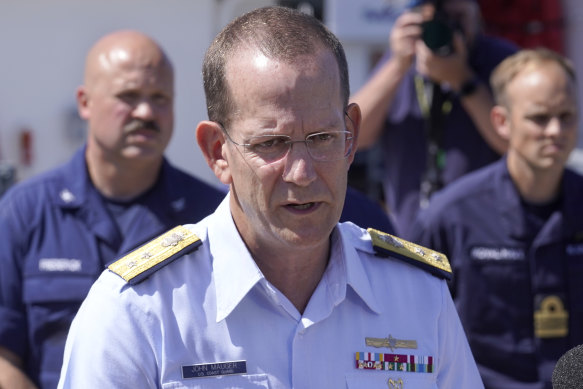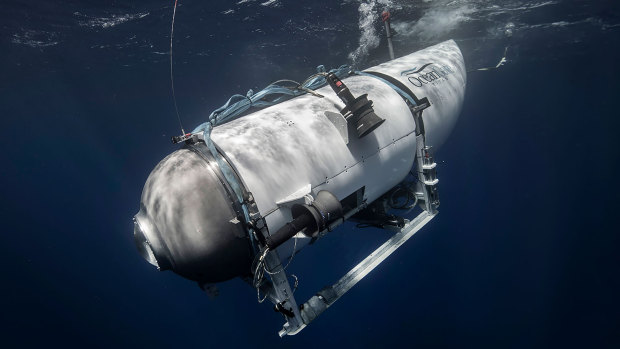This was published 1 year ago
Navy says top secret detection system heard ‘implosion’ after Titan went missing
By Farrah Tomazin
Washington: Five men who went missing during an expedition to see the wreck of the Titanic died after a “catastrophic implosion” of their vessel, marking a tragic end to an international rescue mission across the North Atlantic.
And US Navy has said a top-secret US Navy acoustic detection had heard sounds “consistent with an implosion” in the moments after communication was lost with the vessel.
Four days after the OceanGate Expeditions vessel disappeared off the coast of Canada on Sunday, the US Coast Guard announced that a debris field discovered on the ocean floor near the Titanic on Thursday morning (US time) was linked to the missing submersible.
All five passengers - British billionaire Hamish Harding, British-Pakistani businessman Shahzada Dawood and his son, Suleman; French maritime expert Paul-Henri Nargeolet and OceanGate chief executive Stockton Rush - are now believed to be dead. Their bodies are unlikely to be recovered as an investigation examines what went wrong.
“This morning, an ROV or remote operated vehicle from the vessel Horizon Arctic discovered the tail cone from the Titan submersible approximately 1600 feet (about 487 metres) from the bow of the Titanic on the seafloor,” said Rear Admiral John Mauger.
“The debris is consistent with a catastrophic loss of the pressure chamber. Upon this determination, we immediately notified the families. On behalf of the United States Coast Guard and the entire unified command, I offer my deepest condolences to the families.”
“I can only imagine what this has been like for them and I hope that this discovery provides some solace during this difficult time.”
The desperate search for the 22-foot (6.7-metre) Titan submersible had reached a critical stage on Thursday morning, when the air supply for the five people on board was estimated to have run out.
Around the same time, the US Coast Guard announced on Twitter experts were assessing the findings from a robotic vehicle which was deployed to the sea floor by a Canadian ship, the Horizon Arctic.
Authorities also tweeted they would provide an update at 3pm EST - two hours later than the Coast Guard’s daily updates have been this week, which would have allowed them more time to talk to the families of the Titan’s occupants.

US Coast Guard Rear Admiral John Mauger confirms the deaths of the Titan passengers and crew.Credit: AP
Prior to the press conference, OceanGate said: “We now believe that our CEO Stockton Rush, Shahzada Dawood and his son, Suleman Dawood, Hamish Harding and Paul Henri Nargeolet have sadly been lost.”
“These men were true explorers who shared a distinct spirit of adventure and a deep passion for exploring and protecting the world’s oceans. Our hearts are with these five souls and their families during this tragic time. We grieve the loss and the joy they brought to everyone that they knew.”
The Coast Guard announcement came four days into a search that captivated the world and reignited questions about the growing market for extreme tourism, where individuals are willing to pay hefty amounts of money to view parts the Earth - or space - that most people will never see.
In the case of the Titan, passengers paid $US250,000 ($370,000) for a seat on the van-sized vessel which promised to get them to depths of 4000 metres and give them a glimpse of one of the world’s most famous ship wrecks.

An undated image showing OceanGate’s Titan submersible vehicle.
The van-sized Titan, operated by US-based OceanGate Expeditions, began what was to be a two-hour descent at 8am (10pm AEST) on Sunday but lost contact with its support ship.
The submersible set off with 96 hours of air, according to the company, which means the oxygen would likely have been exhausted by Thursday morning.
Rescuers and relatives of the Titan’s five occupants took hope when the US Coast Guard said on Wednesday that Canadian search planes had recorded undersea noises using sonar buoys earlier that day and on Tuesday.
But remote-controlled underwater vehicles searching where the noises were detected did not yield results, and officials cautioned that sounds might not have originated from the Titan.
Five different pieces of debris were found this morning, including a nose cone outside the pressure hull, a large debris field, and a separate section of the pressure haul.
However, officials say it is too early to tell when the implosion happened, how it occurred, or what might be recovered from the ocean bed.
However, the US Navy later said it had detected an “anomaly consistent with an implosion or explosion” near where the submersible was at the time its communication was lost. The Wall Street Journal, citing unnamed US defence officials, said the sound was picked up by a secret system usually tasked with detecting enemy submarines.
“While not definitive, this information was immediately shared” with commanders of the search mission, a senior Navy official said in a statement first quoted by the Journal.
Asked about the prospect of recovering the bodies of the victims, Mauger replied: “This is an incredibly unforgiving environment down there on the sea floor… We’ll continue to work and continue to search the area down there, but I don’t have an answer for prospects at this time.”
Questions are also likely to emerge about the safety of the Titan amid revelations that OceanGate ignored calls to get its vessel independently checked and certified, believing this would stifle innovation.
Court filings and industry letters from 2018, along with OceanGate’s own website, reveal how the company was warned by employees and external experts that the Titan should undertake rigorous testing and assessments or run the risk of potentially “catastrophic” problems during its expeditions.
However, the company refused insisting that its own safety testing and risk assessments were sufficient.
“We’re going to continue the site of the debris field, and I know there’s a lot of questions about how, why and when this happened,” said Mauger.
“Those are questions that we will collect as much information as we can on now, while the governments are meeting and discussing what an investigation of this nature of casualty might look like.”
“This is something that happened in a remote part of the ocean with people from several different countries from around the world, so it is a complex case to work through, but I’m confident those questions will begin to get answered.”
Get a note directly from our foreign correspondents on what’s making headlines around the world. Sign up for the weekly What in the World newsletter here.